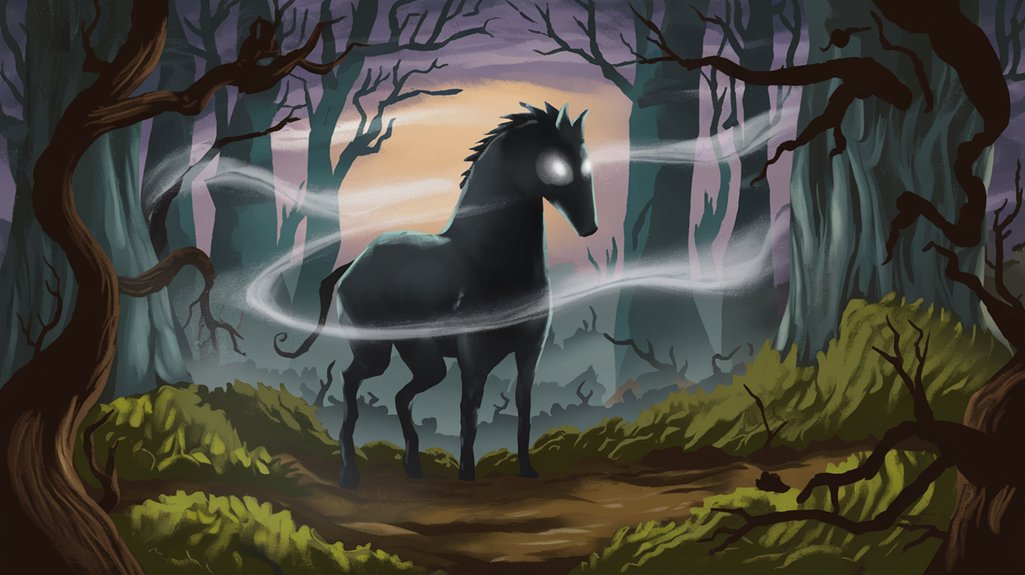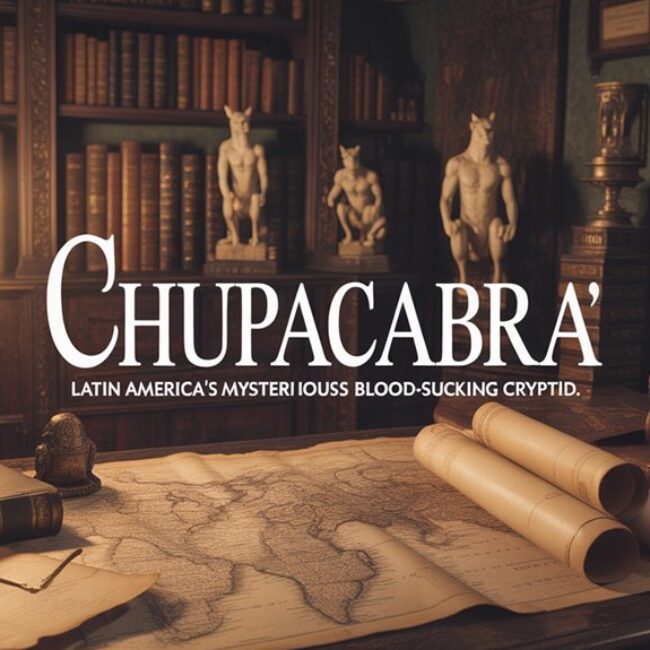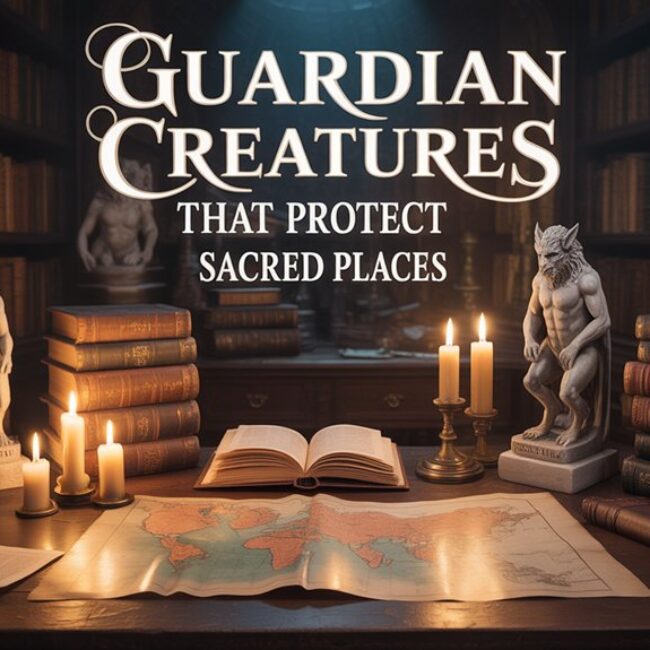You'll recognize the huldra by her breathtaking beauty—luminous skin pale as mountain snow, golden hair like birch bark, eyes reflecting deep forest greens—yet her hollow back, resembling a rotted trunk, and occasional cow's tail mark her as chimeric guardian of Scandinavia's villmark. She embodies the forest's fundamental indifference, drawing men through erotic enchantment into territories where familiar paths become alien configurations and hours dissolve into temporal displacement. Further exploration reveals protective rituals, regional variations across Norwegian, Swedish, and Danish traditions, and her evolution from medieval demon to modern ecological symbol.
🔮 Enhance Your Practice With These Essentials
Chosen for ritual alignment and energetic correspondence.
🔮 Enhance Your Practice With These Essentials
Chosen for ritual alignment and energetic correspondence.
🎯 Recommended Products
Handpicked items related to this article:
As an Amazon Associate, we earn from qualifying purchases.
🔮 Enhance Your Practice With These Essentials
Chosen for ritual alignment and energetic correspondence.
🔮 Enhance Your Practice With These Essentials
Chosen for ritual alignment and energetic correspondence.
Key Takeaways
- Huldra are enchanting forest spirits with luminous beauty, golden hair, and forest-green eyes concealing a hollow back and cow's tail.
- Norwegian, Swedish, and Danish variations differ in physical traits, reflecting regional landscapes and evolving from protective spirits to cautionary figures.
- They serve as warnings against forest dangers, disorientation, and psychological terror in liminal wilderness spaces beyond human civilization.
- Romantic tales depict seductive encounters where men face choices between mortal life and supernatural union after discovering her true nature.
- Protection requires iron amulets, ritual offerings, and church bells, while huldra symbolize untamed nature's indifference and erotic danger.
The Physical Characteristics That Set Huldra Apart
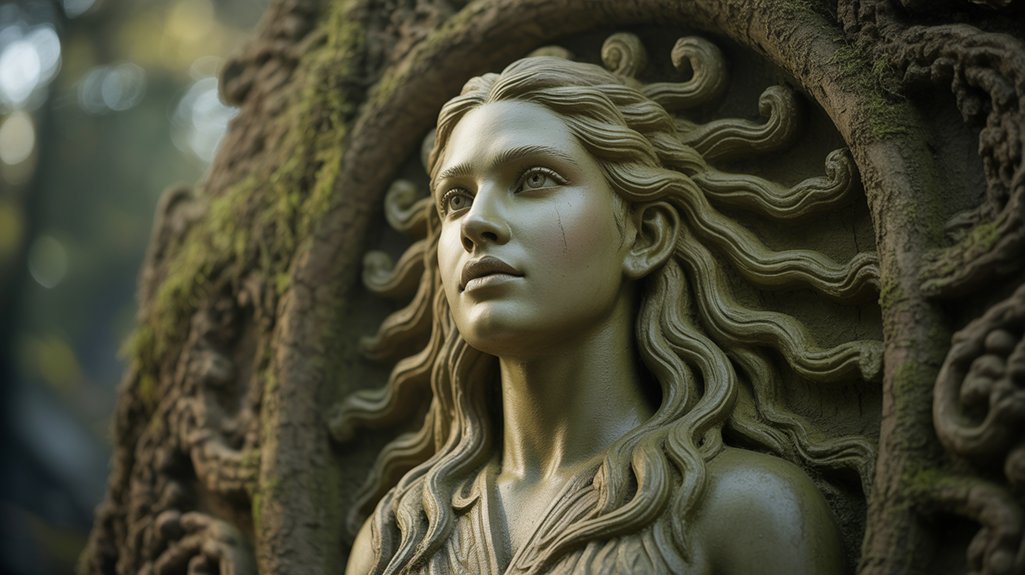
Though the huldra presents herself as breathtakingly beautiful from the front—with cascading hair that gleams like spun gold or darkest birch bark, luminous skin pale as mountain snow, and eyes reflecting the deep greens of primordial forests—her true chimeric nature reveals itself in the details that mark her as irrevocably Other.
Beauty like spun gold concealing the hollow truth—chimeric nature revealed in details that mark her as irrevocably Other.
You'll recognize these huldra features by what she conceals: a hollow back resembling a rotted tree trunk, occasionally a fox's tail brushing beneath her skirts, and in certain Norwegian accounts, the hooves of cattle where feet should be.
This enchanting beauty serves as deliberate camouflage, a survival mechanism perfected across centuries of Nordic folklore. The duality embodies nature's essential paradox—alluring surface masking eldritch danger beneath.
Her voice carries the forest's whisper, her movements echo wind through pine. She belongs neither to human settlements nor entirely to wilderness, existing instead in that liminal threshold where civilization fears to tread.
Complete otherness wrapped in irresistible form.
Like many creatures in Germanic folklore traditions, the huldra reflects a worldview where nature and culture intertwine in ways both enchanting and perilous.
Regional Variations Across Scandinavian Countries
Across the Nordic territories, the huldra fragments into distinct manifestations—each Scandinavian nation preserving its own interpretation of this liminal being, shaped by local landscapes and cultural memory.
You'll encounter chimeric variations as you traverse these ancient woodlands, where regional folklore breathes different life into similar archetypal forms.
Norwegian Huldra: She appears with a cow's tail and hollowed back, dwelling in mountain forests where she guards cattle and lures wanderers. The eldritch void beneath her bark reveals her otherness.
Swedish Skogsrå: This forest spirit manifests without the distinctive tail, presenting a more seductive, less obviously supernatural form that haunts timber regions.
Danish Hulder: Rarely encountered in Danish tales, she exists as diminished echo—the forests having retreated, taking much of her power with them.
These Huldra legends demonstrate how geography dictates mythology.
Mountains breed different mysteries than flatlands. Your freedom to wander these territories means confronting what each culture feared, desired, and ultimately remembered.
The Role of Huldra in Warning Against Forest Dangers
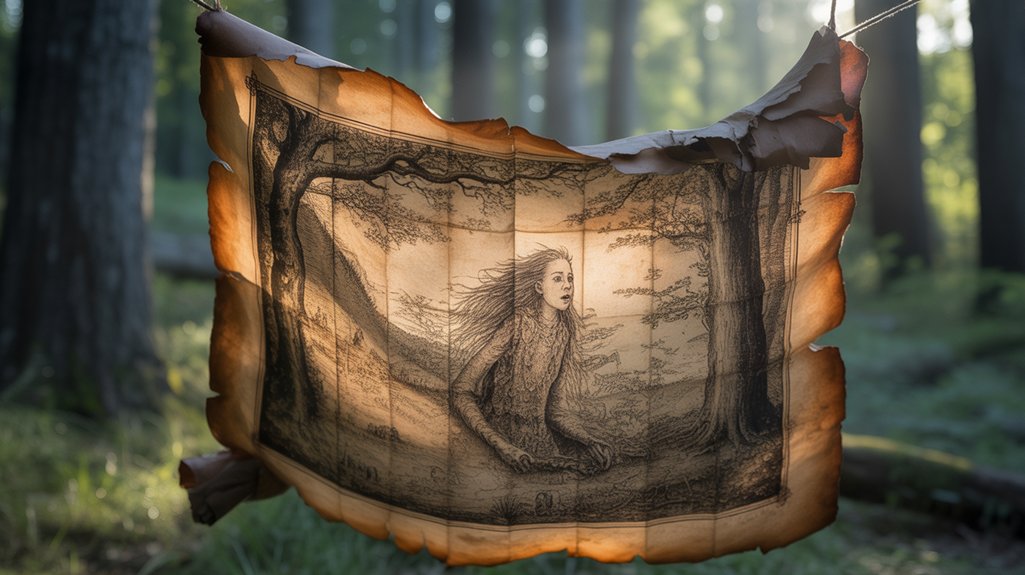
Beyond her seductive allure, the huldra served as an eldritch sentinel whose very presence marked territories where mortals might succumb to disorientation, where familiar paths twisted into labyrinthine corridors of spruce and shadow.
Her appearance signaled zones of genuine peril: marshlands concealing bog holes, territories claimed by wolves and bears, avalanche-prone slopes where snow whispered promises of annihilation.
The folk who encountered her recognized this chimeric being as both threat and warning—a supernatural marker that altered abstract danger into visceral, embodied knowledge that children would remember when wandering too far from hearth smoke.
Disorientation and Getting Lost
While Scandinavian forests offered sustenance and shelter to Nordic communities, their labyrinthine depths harbored a primal terror that transcended mere physical danger—the psychological unraveling that accompanies absolute disorientation.
The huldra embodied this eldritch phenomenon. When you'd venture beyond familiar landmarks, forest navigation deteriorated as her chimeric presence manifested disorienting illusions:
- Spatial distortion: familiar paths twisted into alien configurations, your internal compass rendered useless
- Temporal displacement: hours dissolved into indistinguishable stretches, daylight's passage becoming incomprehensible
- Auditory deception: her laughter echoed from impossible directions, luring you deeper into primordial wilderness
This wasn't mere superstition. The huldra represented ancient recognition that forests could unmoor human consciousness, that freedom without knowledge breeds vulnerability.
She warned: respect these liminal spaces, or succumb to madness.
Wildlife and Natural Hazards
The forest's capacity to unravel minds through disorientation represented only the psychological dimension of its threats—Scandinavian wilderness harbored tangible predators and environmental perils that could maim or kill the unwary traveler.
Wolves prowled the taiga's darkened corridors. Bears emerged from hibernation ravenous, territorial. Swift rivers concealed submerged rocks, hypothermic waters.
The huldra's warnings against these wildlife encounters and natural hazards encoded survival wisdom within eldritch narrative—her presence near dangerous ravines or predator territories served as chimeric sentinel.
When she appeared beckoning deeper into untamed woodland, she manifested your intuition screaming danger. Her legends taught recognition of environmental threat indicators: unusual animal behavior, unstable ground, treacherous ice.
She represented the forest's own voice articulating peril. Freedom demands respect for nature's sovereignty, acknowledgment that wilderness operates by ancient laws indifferent to human ambition.
Tales of Romance Between Huldra and Mortal Men
Throughout Norse and Scandinavian folklore, romantic entanglements between huldra and mortal men constitute perhaps the most pervasive narrative thread—tales wherein desire becomes a threshold between human and eldritch domains.
These huldra love stories reveal the chimeric nature of enchanting encounters that blur boundaries between mortality and supernatural possession.
The archetypal narrative unfolds through distinct stages:
- Initial Seduction: A woodsman encounters a beautiful woman in forest clearings, her alluring voice and ethereal beauty masking her hollow back and cow's tail.
- Passionate Union: The mortal man, entranced by her otherworldly charm, enters into romantic liaison—sometimes consensual, sometimes through glamour and compulsion.
- Revelation and Choice: Discovery of her true nature forces the man to accept or reject her, determining whether he'll remain in the human world or cross permanently into her domain.
These enchanting encounters functioned as cautionary parables, warning those who'd seek freedom in wilderness spaces that liberation carries profound, irreversible consequences.
How to Recognize and Protect Yourself From Huldra
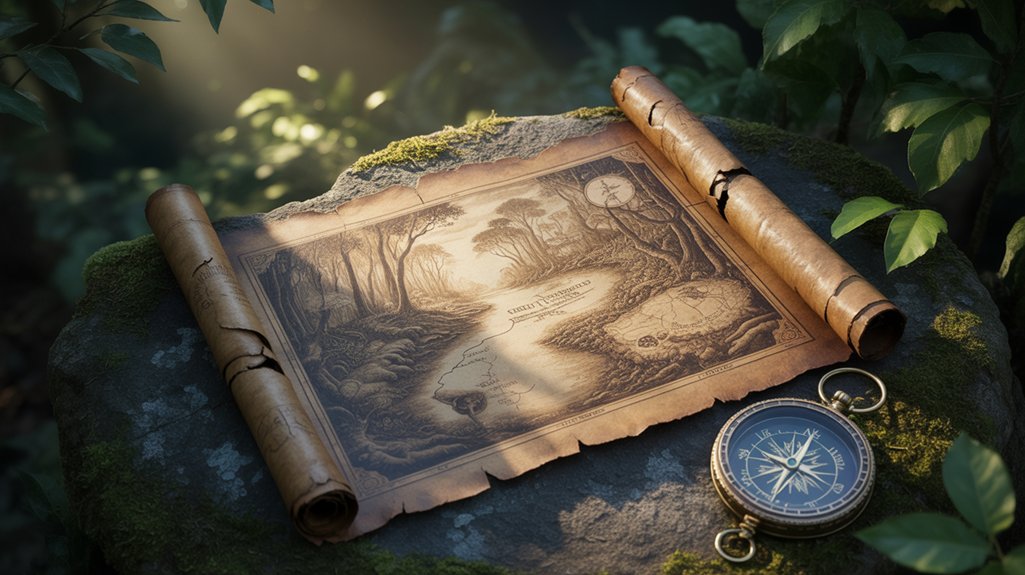
Should you venture into those primordial Scandinavian forests where birch and pine interlace their skeletal branches against pewter skies, you must attune yourself to the huldra's telltale markers—her luminous beauty marred only by the hollow bark concealing her spine, the bovine tail she guards with chimeric vigilance, her footprints that reveal cloven hooves upon closer examination.
The Norwegian *hulder-folk* and Swedish *skogsrå* share these eldritch anatomical anomalies, recorded in folklorist Knut Strompdal's 1892 compendium *Norske Folkeeventyr*, though regional variations persist across the Fennoscandian landscape.
Against such preternatural allure, Nordic tradition prescribed specific apotropaic measures: iron implements carried openly, Christian prayers spoken at forest thresholds, and the utterance of *Vær velsignet* (“be blessed”)—words that strip away enchantment like morning mist beneath unforgiving sunlight.
Physical Signs and Characteristics
Recognizing a huldra requires vigilance toward subtle anatomical aberrations that betray her otherwise flawless human guise. Her enchanting features—luminous skin, cascading hair, hypnotic eyes—constitute deliberate camouflage masking eldritch anatomy beneath.
Critical huldra appearance indicators:
- The hollow back: A concave depression or bark-like texture replaces her spine, concealed by flowing garments and strategic positioning.
- The bovine tail: A cow's appendage emerges from her lower spine, typically hidden within voluminous skirts or wraps.
- The arboreal extremities: Fingers elongating into branch-like protrusions when her chimeric nature surfaces under stress.
These physiological markers distinguish authentic forest entities from mortal women.
You'll notice she positions herself carefully, never fully turning, perpetually managing what you observe. Her movements—deliberate, calculated—betray consciousness of concealment. Trust your instincts when encountering such calculated perfection.
Protective Charms and Rituals
Physical markers alone can't guarantee your safety—knowledge must evolve into action through proven defensive practices.
Scandinavian communities, particularly Norwegian settlements dating from the medieval period through the nineteenth century, deployed protective amulets crafted from iron and consecrated silver—metals believed to repel eldritch entities dwelling within primordial forests. You'd carry these talismans across thresholds, boundaries where chimeric beings exerted greatest influence.
Ritual offerings provided another shield: fresh milk, butter, or bread left at forest edges appeased huldra populations, establishing tentative covenants between human and otherworldly domains. Church bells rung at dawn disrupted their nocturnal enchantments.
Steel beneath your pillow. Salt circling your dwelling. These weren't superstitions but survival protocols, established methods acknowledging that protection required both material defenses and spiritual negotiations with beings who'd inhabited northern woodlands since ancient times.
Huldra as Symbols of Untamed Nature and Wilderness
Where civilization's ordered gardens meet the tangled wilderness, the huldra emerges as a primordial embodiment of nature's untamed essence—neither wholly benevolent nor entirely malevolent, but rather existing in that liminal space where human understanding falters.
You encounter in her figure the forest's sovereign resistance to domestication, its refusal to bend beneath axe and plow.
The huldra personifies nature's allure through three essential aspects:
- Deceptive beauty masking non-human otherness—her hollow back revealing the void beneath appearance
- Territorial guardianship of deep woods—punishing those who violate ancient groves
- Erotic danger that draws men from settled lands—desire as pathway to dissolution
She represents what Norwegian scholars call *villmark*—the untamed wilderness beyond human jurisdiction.
Within her eldritch presence, you confront nature's fundamental indifference to human concerns, its chimeric power to seduce and destroy.
She reminds you that freedom exists beyond civilization's boundaries, where primal forces acknowledge no master.
The Evolution of Huldra Stories Through the Centuries
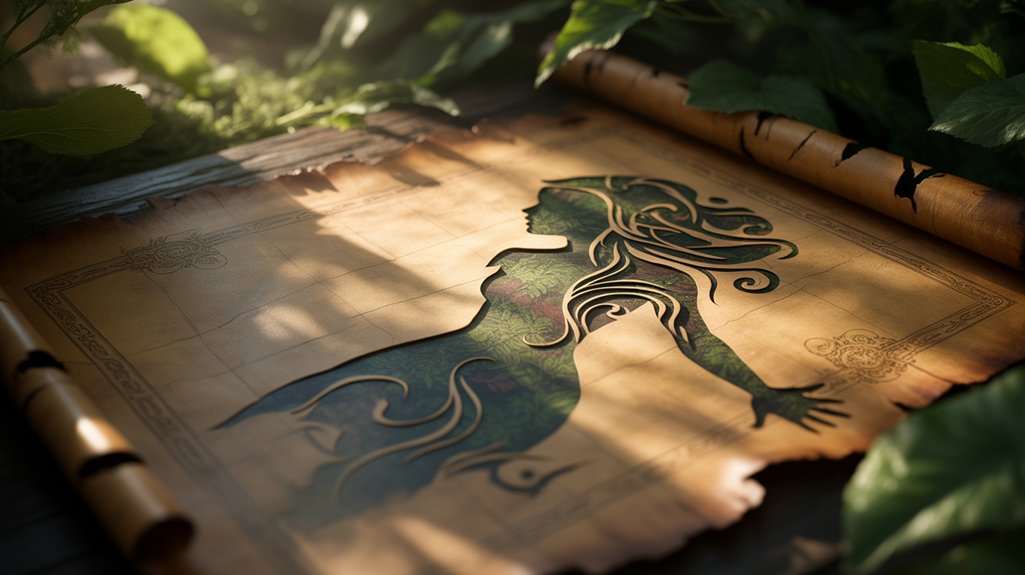
The huldra's metamorphosis across five centuries of Nordic storytelling mirrors the continent's own evolution from animistic pagan society through violent Christianization into modern secular states.
Medieval texts altered her from protective landvættir into cautionary demon, a chimeric warning against straying from sanctified paths. Church scribes documented huldra folklore with deliberate malevolence, inscribing tail and hollow back as marks of infernal origin. Yet she persisted.
The Reformation's grip loosened something essential in these narrative evolution patterns. Seventeenth-century accounts acknowledged her dual nature—dangerous, yes, but also wronged, exiled, searching.
By the nineteenth century's nationalist awakening, folklorists like Asbjørnsen and Moe preserved her eldritch complexity without Christian overlay. You'll find contemporary Scandinavians reclaiming her as ecological symbol, guardian of vanishing wilderness.
She shape-shifts still, adapting to each generation's fears and longings, her hollow back now representing what modernity carved away—that primal connection between human consciousness and untamed earth.
Huldra in Modern Scandinavian Culture and Media
While her ancient roots burrow deep through millennia of forest loam, the huldra's most vigorous flowering manifests in twenty-first century Nordic media—film, literature, television, video games—where she's evolved beyond folklore artifact into active cultural interrogation.
Modern adaptations alter her eldritch essence through contemporary lenses, examining autonomy, environmental sovereignty, feminine power unshackled from patriarchal constraint.
Huldra representation proliferates across:
- Border (2018), where Tina's chimeric otherness becomes metaphor for outsider identity, her hollow-backed anatomy exposing society's brutal taxonomies of belonging
- The Witcher franchise, appropriating her characteristics into broader Slavic-Nordic supernatural synthesis
- Norwegian television series Thale (2012), positioning her within horror's visceral grammar
You'll discover she's abandoned passive seductress roles for complex agency.
She haunts digital forests, cinema screens, novel pages—no longer cautionary specter but embodied challenge to anthropocentric dominance, her tail's revelation transformed from shameful secret into defiant proclamation of irreducible difference.
Connections Between Huldra and Other European Forest Spirits
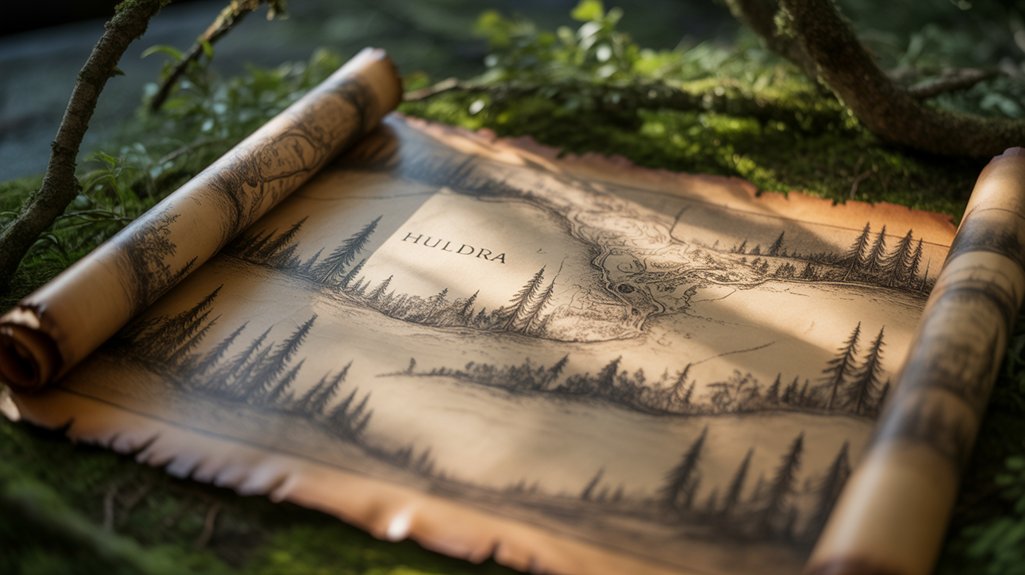
| Spirit Type | Distinguishing Features |
|---|---|
| Huldra (Scandinavia) | Hollow back, cow tail, seductive appearance |
| Rusalka (Slavic) | Water-dwelling, long hair, vengeful nature |
| Vila (Balkan) | Ethereal beauty, storm command, forest guardianship |
| Dryad (Greek) | Tree-bound essence, protective instinct, sylvan wisdom |
These forest spirits function as threshold guardians between civilization's ordered domains and wilderness's untamed sovereignty. They seduce wanderers who transgress sacred boundaries, punishing exploitation while rewarding respectful coexistence. Such beings embody humanity's ancient recognition that nature possesses agency, demanding acknowledgment beyond mere resource extraction.
Frequently Asked Questions
Are Huldra Considered Evil or Benevolent in Scandinavian Folklore?
You'll find huldra characteristics exist in moral ambiguity—neither wholly malevolent nor benevolent, these eldritch beings embody nature's indifferent power.
Their actions mirror your own conduct: respectful travelers receive aid, while those who violate forest sanctity face devastating retribution.
Huldra symbolism reflects Scandinavia's understanding that wilderness operates beyond human ethics, demanding reciprocity rather than mercy.
These chimeric women test your worthiness through seduction and challenge, their hollow-backed forms reminding you that beauty masks dangerous, untamed forces requiring cautious reverence.
Can Huldra Have Children With Human Men?
Yes, you'll find that Huldra offspring emerged from human encounters throughout medieval Scandinavian lore.
These chimeric unions produced children who inherited otherworldly traits—second sight, uncanny beauty, eldritch powers tied to forest domains.
Norwegian folklore documents such lineages from the 13th century onward, families claiming huldra ancestry.
The children walked between worlds, never fully mortal, bearing gifts and curses.
Your bloodline, once touched by the forest women, altered forever, marking generations with their wild, untameable essence.
What Happens if You Break a Promise to a Huldra?
You'll face huldra revenge swift and merciless—broken promises release her eldritch fury.
Picture ancient pines twisting toward you, their shadows clawing at your freedom. She'll curse your livestock, wither your crops, drive you mad with phantom whispers threading through dawn's mist.
The Scandinavian forest spirits don't forget betrayal. Your fate becomes bound to her wrath, each day bleeding into sleepless nights where chimeric visions haunt you.
She'll guarantee you understand: oaths made to the huldra transcend mortal convenience.
Do Huldra Stories Appear in Ancient Norse Mythology or Sagas?
You won't find huldra in ancient sagas or Norse mythology's earliest strata. These eldritch forest beings emerge from later Scandinavian folklore, crystallizing during medieval and post-medieval periods—centuries after the Eddas were composed.
The ancient sagas focused on gods, heroes, and cosmic battles, while huldra legends developed among rural communities, weaving together pre-Christian animistic beliefs with Christian moral frameworks.
They're folkloric descendants, not primordial mythological entities, representing localized spiritual traditions that evolved independently from codified Norse mythology.
Are There Male Equivalents of Huldra in Scandinavian Folklore?
You'll encounter the huldrekall, the male counterpart dwelling in Norway's primordial forests—imagine stumbling upon this eldritch being, his form twisted and chimeric, unlike his female kin's beauty.
These male forest spirits of Scandinavian folklore remain far rarer in the oral traditions, manifesting as grotesque, moss-covered entities.
Where huldra seduce through allure, huldrekall embody the wilderness's darker aspects: gnarled, ancient, dangerous.
They guard secret knowledge, territorial and solitary, representing untamed masculine power that refuses civilization's constraints.
Conclusion
You've glimpsed the huldra's chimeric form, traced her evolution through centuries of Nordic lore, examined her place among Europe's eldritch forest dwellers. You've learned her warning signs, understood her seductive dangers, recognized her embodiment of wilderness untamed. Now you stand at that liminal threshold between empirical knowledge and ancient reverence, between the mapped world and the forest's shadowed depths. The huldra endures—neither wholly myth nor memory, but something dwelling between.


